United States
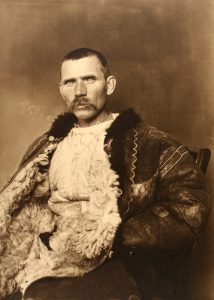
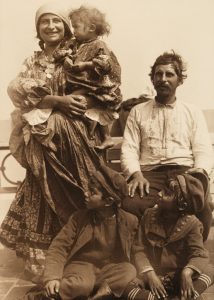
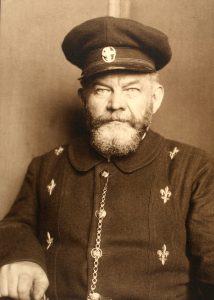 The United States has long been known as “The Melting Pot,” in reference to the immigration of many of its citizens. The United States was not a country that began with all of its people in place. I suppose no nation was really. There is, however, a legal way to immigrate, and an illegal way to sneak into a country. For the purpose of this story, the melting pot refers only to legal immigration. Beginning in 1892, and continuing until 1924, Ellis Island, located in New York Harbor, was the entrance for immigrants entering the United States. Not everyone who entered the United States had to go through Ellis Island, however. First and Second Class passengers were not so required. They were allowed to do all of their immigration paperwork, and inspections onboard the ship that arrived on. The Third Class passengers, however, were required to go through Ellis Island. There, they had medical exams and legal inspections to determine if they were fit for entry into the United States.
The United States has long been known as “The Melting Pot,” in reference to the immigration of many of its citizens. The United States was not a country that began with all of its people in place. I suppose no nation was really. There is, however, a legal way to immigrate, and an illegal way to sneak into a country. For the purpose of this story, the melting pot refers only to legal immigration. Beginning in 1892, and continuing until 1924, Ellis Island, located in New York Harbor, was the entrance for immigrants entering the United States. Not everyone who entered the United States had to go through Ellis Island, however. First and Second Class passengers were not so required. They were allowed to do all of their immigration paperwork, and inspections onboard the ship that arrived on. The Third Class passengers, however, were required to go through Ellis Island. There, they had medical exams and legal inspections to determine if they were fit for entry into the United States.
It is estimated that 12 million immigrants came through Ellis Island in those years. In all, about 2% were denied entrance into the United States. Our nation was quite generous with its legal immigration requests. One 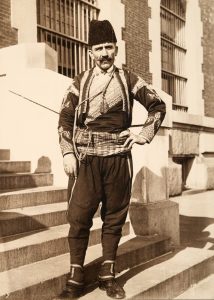
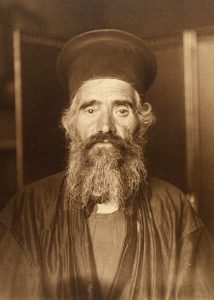 of the main reasons for the opening of Ellis Island was the change in the immigration requests. “Fewer arrivals were coming from northern and western Europe—Germany, Ireland, Britain and the Scandinavian countries—as more and more immigrants poured in from southern and eastern Europe. Among this new generation were Jews escaping from political and economic oppression in czarist Russia and eastern Europe (some 484,000 arrived in 1910 alone) and Italians escaping poverty in their country. There were also Poles, Hungarians, Czechs, Serbs, Slovaks and Greeks, along with non-Europeans from Syria, Turkey and Armenia. The reasons they left their homes in the Old World included war, drought, famine and religious persecution, and all had hopes for greater opportunity in the New World.”
of the main reasons for the opening of Ellis Island was the change in the immigration requests. “Fewer arrivals were coming from northern and western Europe—Germany, Ireland, Britain and the Scandinavian countries—as more and more immigrants poured in from southern and eastern Europe. Among this new generation were Jews escaping from political and economic oppression in czarist Russia and eastern Europe (some 484,000 arrived in 1910 alone) and Italians escaping poverty in their country. There were also Poles, Hungarians, Czechs, Serbs, Slovaks and Greeks, along with non-Europeans from Syria, Turkey and Armenia. The reasons they left their homes in the Old World included war, drought, famine and religious persecution, and all had hopes for greater opportunity in the New World.”
At one point, one of the men working on Ellis Island decided to bring his camera, and document the variety of people coming through. His photos really do show the “melting pot” that the United States was. He photographed a Romanian shepherd, a Serbian gypsy family, Danish captain, a bearded Greek priest, a Turkish bank guard, an Albanian soldier, an Algerian (wearing his finest clothes), and a tattooed German stowaway (who was eventually deported). It gives an inside look at the varied people who came to the United States, 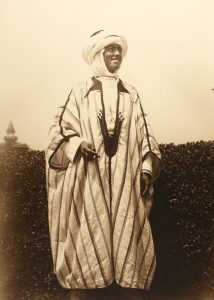
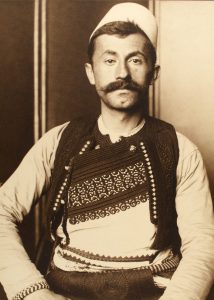
 and these were just the third class passengers, seen on Ellis Island.
and these were just the third class passengers, seen on Ellis Island.
Ellis Island was used as an immigration center until 1924, at which time it was used until 1954 as a detention and deportation center for illegal immigrants. Now it is a museum, and a place where people can go to see if their ancestors came through on their way to a better life. The island had a varied past, and played a major role in creating “The Melting Pot” the United States was.

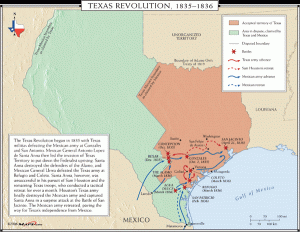 Since the 17th century, Texas, or Tejas as the Mexicans called it, had technically been a part of the Spanish empire. However, there were only about 3,000 Spanish-Mexican settlers in Texas, even as late as the 1820s, and Mexico City’s hold on the territory was very weak. Tensions were growing between Mexico and Texas, and on October 2, 1835, the area erupted into violence when Mexican soldiers attempted to disarm the people of Gonzales. People just don’t take kindly to having their guns taken away in any era, I guess. The citizens of Texas chose a war for independence of allowing the government to take their guns.
Since the 17th century, Texas, or Tejas as the Mexicans called it, had technically been a part of the Spanish empire. However, there were only about 3,000 Spanish-Mexican settlers in Texas, even as late as the 1820s, and Mexico City’s hold on the territory was very weak. Tensions were growing between Mexico and Texas, and on October 2, 1835, the area erupted into violence when Mexican soldiers attempted to disarm the people of Gonzales. People just don’t take kindly to having their guns taken away in any era, I guess. The citizens of Texas chose a war for independence of allowing the government to take their guns.
Mexico had just won it’s own independence from Spain in 1821. At this point, Mexico welcomed large numbers of Anglo-American immigrants into Texas. They were hoping that these citizens would become loyal Mexican citizens, thereby keeping the territory from falling into the hands of the United States. During the next decade men like Stephen Austin brought more than 25,000 people to Texas, most of them Americans. But while these emigrants legally became Mexican citizens, they continued to speak English, formed their own schools, and had closer trading ties to the United States than to Mexico.
The situation exacerbated in 1835, the president of Mexico, Antonio Lopez de Santa Anna, overthrew the constitution and appointed himself dictator. Recognizing that the “American” Texans were likely to use his rise to power as an excuse to secede, Santa Anna ordered the Mexican military to begin disarming the Texans whenever possible. He underestimated the people. His attempt to disarm proved more difficult than he could have ever imagined, and the situation exploded on that October day in 1835.
That day, the Mexican soldiers were attempting to take a small cannon from the village of Gonzales. To their surprise, they encountered much stiffer resistance than they ever thought possible from a hastily assembled militia of Texans. After a rather brief fight, the Mexicans retreated and the Texans kept their cannon. The determined Texans would continue to battle Santa Ana and his army for another year and a half before winning their independence and establishing the Republic of Texas. This truly goes to show that a nation, whose citizens are armed, is much more likely to be able to fend off their enemies…even if that enemy is a tyrannous government; than an nation of disarmed citizens. Yes, the ensuing war lasted for another year and a half, but 
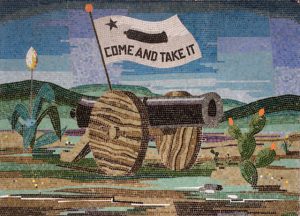 the people won their independence in the end. They later went on to become a part of the United States, and they continue to carry their guns to this day. The people of Texas are just as adamant about their right to bear arms today as they were in 1835, as are a good number of their fellow Americans. It’s a fight that would not likely be won by the government today either. The American people won’t accept the loss of guns without a fight of epic proportions!!
the people won their independence in the end. They later went on to become a part of the United States, and they continue to carry their guns to this day. The people of Texas are just as adamant about their right to bear arms today as they were in 1835, as are a good number of their fellow Americans. It’s a fight that would not likely be won by the government today either. The American people won’t accept the loss of guns without a fight of epic proportions!!
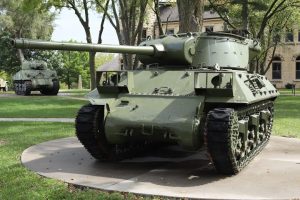 After World War II, the GIs who had fought in the war, came home, eager to start their lives over. Many went to the car dealerships to buy new cars, only to find that there were no new cars to be found. What a bizarre thought!! In my entire lifetime, I don’t know of a time that new cars weren’t available, but there was a reason for the lack of new cars.
After World War II, the GIs who had fought in the war, came home, eager to start their lives over. Many went to the car dealerships to buy new cars, only to find that there were no new cars to be found. What a bizarre thought!! In my entire lifetime, I don’t know of a time that new cars weren’t available, but there was a reason for the lack of new cars.
During World War II, the whole United States “kicked in” on the war effort. The automobile industry changed the production in their factories from automobiles to whatever was needed for the war effort. The United States automakers manufactured a wide variety of vehicles, munitions, and more 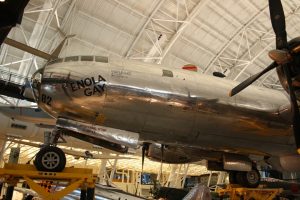 for the government. They made tanks like the Fisher Body Grand Blanc, the Ford M10 Wolverine, and the M18 Hellcat, which were produced by the Buick Motor Car Division of General Motors. Some of the automakers were tasked with producing parts for planes, including the infamous Enola Gay. The 18-foot nose section of the fuselage was built by Chrysler. Chevrolet alone produced 60,000 engines for Pratt and Whitney cargo and bomber planes between 1942 and 1945, along with 500,000 trucks, 8 million artillery shells, and much more. The tire company, Firestone Tire and Rubber Company produced the 40 mm cannon gun mount one of which was placed on the deck of the USS Cod, while another was mounted on the
for the government. They made tanks like the Fisher Body Grand Blanc, the Ford M10 Wolverine, and the M18 Hellcat, which were produced by the Buick Motor Car Division of General Motors. Some of the automakers were tasked with producing parts for planes, including the infamous Enola Gay. The 18-foot nose section of the fuselage was built by Chrysler. Chevrolet alone produced 60,000 engines for Pratt and Whitney cargo and bomber planes between 1942 and 1945, along with 500,000 trucks, 8 million artillery shells, and much more. The tire company, Firestone Tire and Rubber Company produced the 40 mm cannon gun mount one of which was placed on the deck of the USS Cod, while another was mounted on the 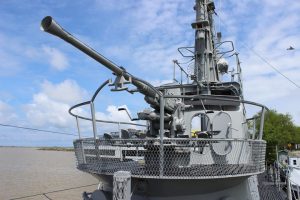 stern of PT-305. Pontiac Motor Car Division built aerial launched torpedoes at its facilities in Pontiac, Michigan.
stern of PT-305. Pontiac Motor Car Division built aerial launched torpedoes at its facilities in Pontiac, Michigan.
By the time the World War II ended in 1945, the total value of goods produced by the United States auto industry for the war would exceed $29 million, equal to nearly $400,000,000 today. There had been no new cars built in the United States between early 1942 and late 1945. Once the war was over, automakers were again free to begin manufacturing new cars for the American public. That was all well and good, but it would take time to bring production of automobiles back up to speed. The first car built for civilian sale after World War II, was a Super Deluxe Ford. It rolled off the assembly line on July 3, 1945.
 I recently read a book about the orphan trains, which ran between 1854 and 1929. During that time, approximately 250,000 orphaned, abandoned, and homeless children ride the train throughout the United States and Canada, to be placed with families who were looking for a child, or just as often, a worker for their farm. The orphan train movement was necessary, because at the time, it was estimated that 30,000 abandoned children were living in the streets in New York City. I had heard of the orphan trains, mostly from the movie called “Orphan Train,” but much of what really happened with those children was very new to me, and quite shocking.
I recently read a book about the orphan trains, which ran between 1854 and 1929. During that time, approximately 250,000 orphaned, abandoned, and homeless children ride the train throughout the United States and Canada, to be placed with families who were looking for a child, or just as often, a worker for their farm. The orphan train movement was necessary, because at the time, it was estimated that 30,000 abandoned children were living in the streets in New York City. I had heard of the orphan trains, mostly from the movie called “Orphan Train,” but much of what really happened with those children was very new to me, and quite shocking.
Today, while my husband, Bob Schulenberg and I were in the Black Hills, we rode the 1880 Train, as we almost always do when we are here. When they mentioned that the train had been 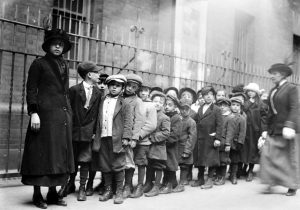 used in the movie “Orphan Train,” a fact that I had heard many times before, the stories from the book I had read came back to mind. My mind instantly meshed to train, the book, and the movie into one event.
used in the movie “Orphan Train,” a fact that I had heard many times before, the stories from the book I had read came back to mind. My mind instantly meshed to train, the book, and the movie into one event.
The children who traveled on the orphan trains were victims of circumstance, and they had no control over their lives at all. Each one hoped that their new family would be nice. The older ones didn’t have high hopes. The older boys pretty much knew that they would be farm hands. And most of them were right many were made to sleep in the barn, because they were thought to be thieves. If they were thieves, it was because they had to steal to survive. They did whatever it took to survive.
 As Bob and I rode the train today, in the eye of my imagination, I could picture what it must have been like to be one of those orphans. The were sitting there watching that big steam engine take them to someplace they didn’t know, and probably didn’t want to go. They didn’t have high hopes for a great future, but then again, the past wasn’t that great either. They were forced to make the best of a bad situation, and the people who were in charge didn’t really care what happened to them. They were just doing their jobs. I have ridden the 1880 Train many times before, but today, it felt a little bit different, somehow. I knew that I wasn’t an orphan riding that train, but I certainly felt empathy for the children who were.
As Bob and I rode the train today, in the eye of my imagination, I could picture what it must have been like to be one of those orphans. The were sitting there watching that big steam engine take them to someplace they didn’t know, and probably didn’t want to go. They didn’t have high hopes for a great future, but then again, the past wasn’t that great either. They were forced to make the best of a bad situation, and the people who were in charge didn’t really care what happened to them. They were just doing their jobs. I have ridden the 1880 Train many times before, but today, it felt a little bit different, somehow. I knew that I wasn’t an orphan riding that train, but I certainly felt empathy for the children who were.
 I have long been interested in war, and especially World War II. Every aspect of it interests me, and I find myself wondering about the enemy. I’m sure that might seem odd to many people, but as we have found in the United States, just because the government goes to war, does not mean that every citizen, or even every soldier agrees with the reasons the country has gone to war. I have been listening to a couple of audiobooks that have taken in D-Day, and I came across something interesting.
I have long been interested in war, and especially World War II. Every aspect of it interests me, and I find myself wondering about the enemy. I’m sure that might seem odd to many people, but as we have found in the United States, just because the government goes to war, does not mean that every citizen, or even every soldier agrees with the reasons the country has gone to war. I have been listening to a couple of audiobooks that have taken in D-Day, and I came across something interesting.
Without going into all of that amazing strategy of warfare, I want to focus on one of the bombing maneuvers that took place. One of the soldiers on the ground was trying to take cover from incoming German bombs. After the bombing stopped, he looked out and was shocked to see eight bombs embedded in the ground near his foxhole. They had not gone off. He knew that it is possible for bombs to be duds, but he hadn’t heard of any American bombs that had turned out to be duds…especially eight of them at the same time, in the same place.  He wasn’t bragging on the American bombs, their craftmanship, or their ingenuity, but rather, wondering how so many German bombs could have been duds…all at the same time.
He wasn’t bragging on the American bombs, their craftmanship, or their ingenuity, but rather, wondering how so many German bombs could have been duds…all at the same time.
Then the soldier made an observation that I had not considered, but that fell right into my view that not everyone in Germany agreed with Hitler. The American bomb builders were doing their job willingly. They were working to make the bombs efficient, because Germany needed to be defeated. In contrast, the German bomb builders were actually Polish slaves. Hitler had invaded their nation and was forcing them to play a part in a war that they disagreed with. The soldier considered these things and came to the conclusion that somehow the Polish slaves had been able to build a bomb that they knew would not explode, but would still pass the inspections of the Germans. The soldier believed that eight unexploded bombs could not be coincidental. It had to be sabotage.
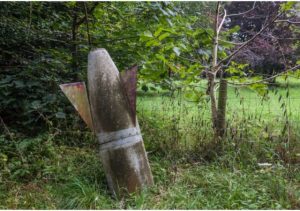
In my research, I have seen situations where the citizens have helped the enemy, at great risk to their own safety. I have seen situations where the citizens have given aid to the enemy. And this situation was a blatant sabotage of the weapons of warfare. Within their nations, these acts were acts of treason, but they were actually fighting the evil that had tried to take over their nation. Within their confines, they were standing up for their values…for good, and for what was right. They were the enemy, in location only, because in their hearts, the were fighting for what was right, and I have to respect them for that.
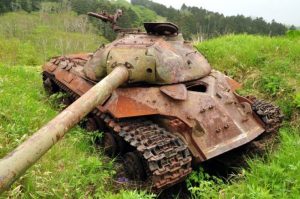 War machines…the weapons of war…everything from tanks to airplanes to ships. A war cannot be fought without the equipment that transports, shoots, bombs, floats, and flies over the war. What happens to the shattered remains of the equipment that didn’t make it back to base? Obviously, if a ship is hit, it ends up at the bottom of the ocean, as does a submarine, but what of the planes, tanks, jeeps, and even the bases that have been bombed out, shot up, or otherwise rendered useless? The world is littered with the wreckage of the many wars that have taken place over the years of human existence, because humans have a propensity for fighting. We don’t like when things don’t go our way, and if we don’t understand that we can’t always have it our way, we tend to go to war.
War machines…the weapons of war…everything from tanks to airplanes to ships. A war cannot be fought without the equipment that transports, shoots, bombs, floats, and flies over the war. What happens to the shattered remains of the equipment that didn’t make it back to base? Obviously, if a ship is hit, it ends up at the bottom of the ocean, as does a submarine, but what of the planes, tanks, jeeps, and even the bases that have been bombed out, shot up, or otherwise rendered useless? The world is littered with the wreckage of the many wars that have taken place over the years of human existence, because humans have a propensity for fighting. We don’t like when things don’t go our way, and if we don’t understand that we can’t always have it our way, we tend to go to war.
On an island in the North Pacific, lies a remote island called Shikotan, at the southern end of the Kuril archipelago. The island seems like a simple place, green and lush in the summertime, but the island hides a secret. It has one particularly astonishing characteristic. The island is dotted with the decaying hulks of Russian 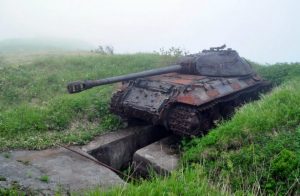 military tanks from the 1950s. And these rusting relics hint at the troubled past…and present of Shikotan. Shikotan is a part of an ongoing battle for ownership between Russia and Japan.
military tanks from the 1950s. And these rusting relics hint at the troubled past…and present of Shikotan. Shikotan is a part of an ongoing battle for ownership between Russia and Japan.
Shikotan is part of the Kuril archipelago, a chain of islands stretching from the southeastern tip of Russia to the north of the Japanese island of Hokkaido. The Pacific lies on one side of the Kuril Islands, with the Sea of Okhotsk found on the other. Its location makes it an important island to both countries, hence the battle. After World War II, the San Francisco Peace Treaty, which was signed between the Allies and Japan in 1951, stated that Japan must give up “all right, title and claim to the Kuril Islands.” Unfortunately, it didn’t specifically recognize the Soviet Union’s sovereignty over them. That allowed the dispute that has ensued. Japan claims that at least some of the disputed islands are not a part of the Kuril Islands, and thus are not covered by the treaty. Russia maintains that the Soviet Union’s sovereignty over the islands was recognized in post-war agreements.
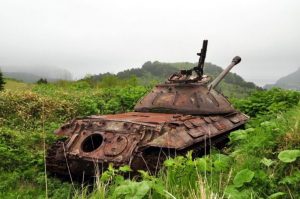
Since that time, Japan and the Soviet Union had been fighting over the island. They finally ended their formal state of war with the Soviet–Japanese Joint Declaration of 1956, but did not resolve the territorial dispute. During talks leading to the joint declaration, the Soviet Union offered Japan the two smaller islands of Shikotan and the Habomai Islands in exchange for Japan renouncing all claims to the two bigger islands of Iturup and Kunashir, but Japan refused the offer after pressure from the US. Japan did not really intend to give up the island, and no one really knows how strong their army there was, but what is left on the island are the remnants of that army…a few masterpieces of Soviet engineering, IS-2 and IS-3 tanks.

 World War II had dragged on for almost six years, when the United States took things to the next, and as it turns out, final level. For quite some time, Japan had been one of the forces to be reckoned with. Now, with so much new technology, a plan has begun to form to put an end to this war, once and for all. The Japanese had no idea what was coming…how the 6th of August, 1945 would change things forever.
World War II had dragged on for almost six years, when the United States took things to the next, and as it turns out, final level. For quite some time, Japan had been one of the forces to be reckoned with. Now, with so much new technology, a plan has begun to form to put an end to this war, once and for all. The Japanese had no idea what was coming…how the 6th of August, 1945 would change things forever.
That August 6th in 1945 dawned like any other day, but at it’s end, the world would find that everything had changed. The power to destroy whole cities in an instant was in our hands. At 8:16am, an American B-29 bomber dropped the world’s first deployed atomic bomb over the Japanese city of Hiroshima. The ensuing explosion wiped out 90 percent of the city and immediately killed 80,000 people. Tens of thousands more would later die of radiation exposure. Three days later, on August 9, 1945, a second B-29 dropped another 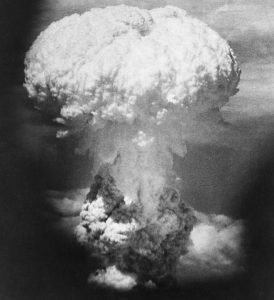 A-bomb on Nagasaki, killing an estimated 40,000 people. With these two events, it was very clear that the nations had the ability to bring mass destruction. Hopefully, they would also have the compassion, not to do it.
A-bomb on Nagasaki, killing an estimated 40,000 people. With these two events, it was very clear that the nations had the ability to bring mass destruction. Hopefully, they would also have the compassion, not to do it.
With such a show of power, Japan’s Emperor Hirohito announced his country’s unconditional surrender to the Japanese people in World War II in a radio address on August 14th, citing the devastating power of “a new and most cruel bomb” as the reason Japan could no longer stand against the Allies. I’m sure the war-ravaged people of Japan were almost relieved. Of course, that meant that they did not know what their future would bring, but the recent past hadn’t been so great either, so they didn’t have too much to lose really.
Japan’s War Council, urged by Emperor Hirohito, submitted a formal declaration of surrender to the Allies, on August 10, but the fighting continued between the Japanese and the Soviets in Manchuria and between the Japanese and the United States in the South Pacific. During that time, a Japanese submarine attacked the Oak Hill, an American landing ship, and the Thomas F. Nickel, an American destroyer, both east of Okinawa. On August 14, when Japanese radio announced that an Imperial Proclamation was coming soon, in which Japan would accept the terms of unconditional surrender drawn up at the Potsdam Conference. The news did not go over well. More than 1,000 Japanese soldiers stormed the Imperial Palace in an attempt to find the 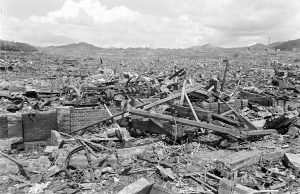
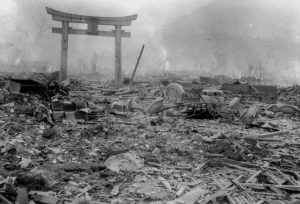 proclamation and prevent its being transmitted to the Allies. Soldiers still loyal to Emperor Hirohito held off the attackers. That evening, General Anami, the member of the War Council most adamant against surrender, committed suicide. His reason was to atone for the Japanese army’s defeat, and he refused to hear his emperor speak the words of surrender. I guess the surrender was not a relief to everyone.
proclamation and prevent its being transmitted to the Allies. Soldiers still loyal to Emperor Hirohito held off the attackers. That evening, General Anami, the member of the War Council most adamant against surrender, committed suicide. His reason was to atone for the Japanese army’s defeat, and he refused to hear his emperor speak the words of surrender. I guess the surrender was not a relief to everyone.
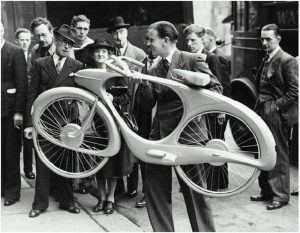
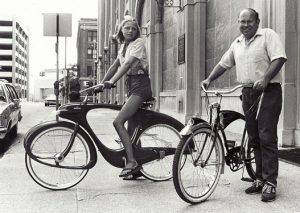 Today it would be worth about $4750. Would you pay that much for a bicycle? I don’t think I would, but then I don’t suppose I would be buying a bicycle called the Spacelander. Still, if I was, $4750 would be the asking price, or something close to that number. The Spacelander was created by Benjamin Bowden, who was born June 3, 1906. He was a British industrial designer, whose specialty was automobiles and bicycles. He received violin training at Guildhall, and completed a course in engineering at Regent. Bowden designed the coachwork of Healey’s Elliott, an influential British sports car.
Today it would be worth about $4750. Would you pay that much for a bicycle? I don’t think I would, but then I don’t suppose I would be buying a bicycle called the Spacelander. Still, if I was, $4750 would be the asking price, or something close to that number. The Spacelander was created by Benjamin Bowden, who was born June 3, 1906. He was a British industrial designer, whose specialty was automobiles and bicycles. He received violin training at Guildhall, and completed a course in engineering at Regent. Bowden designed the coachwork of Healey’s Elliott, an influential British sports car.
In 1925 Bowden began working as an automobile designer for the Rootes Group. By the late 1930s, Bowden was the chief body engineer for the Humber car factory in Coventry. During World War II, his design of an armored car was used by Winston Churchill and George VI for their protection. In 1945, he left the Rootes Group, and with partner John Allen, formed his own design company in Leamington Spa. The studio was one of the first such design firms in Britain. Bowden designed the body of Healey’s Elliott in 1947. It was the first British car to break the 100 mile per hour barrier. Working with Achille Sampietro who created the chassis, Bowden drew the initial design for the auto directly onto the walls of his house. Unusual…yes, but it worked for him, I guess. Shortly before his departure to the United States Bowden penned a sketch design for a two-seater sports racing prototype, the Zethrin Rennsport, being developed by Val Zethrin. This used the same wheelbase as the short-chassis Squire Sports, and was dressed in a contemporary, streamlined body. This design theme was carried through to his future work on the early Chevrolet Corvette and Ford Thunderbird.
He went on to design the Spacelander in 1946. It was a space-age looking bicycle, that was ahead of its time, since space travel wouldn’t occur for two decades. It’s not that the Spacelander would ever be used in space, but rather the design that seemed space-like. Bowden called the bicycle the Classic. In the early or mid 1950s, Bowden moved to Michigan, in the United States. While in Muskegon, Michigan in 1959, he met with Joe Kaskie, of the George Morrell Corporation, a custom molding company. Kaskie suggested molding the bicycle in fiberglass instead of aluminum, but the fiberglass frame was relatively fragile, and its unusual nature made it difficult to market to established bicycle distributors. Although he retained the futuristic appearance of the Classic, Bowden abandoned the hub dynamo, and replaced the drive-train with a more common sprocket-chain assembly. The new name, Spacelander, was chosen to capitalize on interest in the Space Race. Financial 
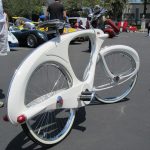 troubles from the distributor forced Bowden to rush development of the Spacelander, which was released in 1960 in five colors: Charcoal Black, Cliffs of Dover White, Meadow Green, Outer Space Blue, and Stop Sign Red. The bicycle was priced at $89.50, which made it one of the more expensive bicycles on the market. Only 522 Spacelander bicycles were shipped before production was stopped, although more complete sets of parts were manufactured. In more recent years, the Spacelander has become a collector’s item…hence the price tag.
troubles from the distributor forced Bowden to rush development of the Spacelander, which was released in 1960 in five colors: Charcoal Black, Cliffs of Dover White, Meadow Green, Outer Space Blue, and Stop Sign Red. The bicycle was priced at $89.50, which made it one of the more expensive bicycles on the market. Only 522 Spacelander bicycles were shipped before production was stopped, although more complete sets of parts were manufactured. In more recent years, the Spacelander has become a collector’s item…hence the price tag.
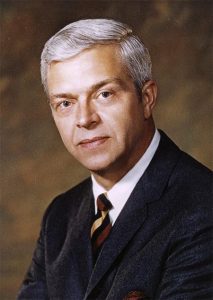 With the arrival of the 50th anniversary of the landing on the moon, on July 20, 2019, many people have been reviewing old footage and books about the event. I came across a book that caught my eye on Audible. The book, The Man Who Knew The Way To The Moon, by Todd Zwillich wasn’t exactly about the moon landing, but rather how it became possible. The book begins with Russia beating the United States to the punch when they sent a man Yuri Alekseyevich Gagarin, into space on April 12, 1961. As short as the flight was…just 89 minutes…it was still an embarrassment to the United States who felt they should have been first.
With the arrival of the 50th anniversary of the landing on the moon, on July 20, 2019, many people have been reviewing old footage and books about the event. I came across a book that caught my eye on Audible. The book, The Man Who Knew The Way To The Moon, by Todd Zwillich wasn’t exactly about the moon landing, but rather how it became possible. The book begins with Russia beating the United States to the punch when they sent a man Yuri Alekseyevich Gagarin, into space on April 12, 1961. As short as the flight was…just 89 minutes…it was still an embarrassment to the United States who felt they should have been first.
In answer to the Soviet space flight, President Kennedy challenged NASA to put a man on the moon before the end of the decade. NASA sort of panicked. Yes, they had been thinking about a moon landing…and some remote point down the road, but they were nowhere near ready to go them by the end of the decade. Nevertheless, they began to explore ideas to make it happen. One of those people who had been considering a way to make the landing possible. By this time, no one doubted the ability to go into space, and to safely return to earth. Landing on the moon was a different story.
The widely accepted method of landing on the moon was to have the original rocket back onto the moon, carrying enough fuel to take off again and return to Earth. A man named John Houbolt thought that was…well, simply impossible. Now, I’m no aeronautical engineer, like Houbolt was, and maybe I have the advantage of  knowing about the past space exploration victories, but when I think about three astronauts backing a 90 foot high, fully fueled rocket onto the moon…all I can say is, “That’s ludicrous!!” People often say that an idea doesn’t take a rocket scientist, and it this case, maybe it shouldn’t be a rocket scientist, but rather an aeronautical engineer.
knowing about the past space exploration victories, but when I think about three astronauts backing a 90 foot high, fully fueled rocket onto the moon…all I can say is, “That’s ludicrous!!” People often say that an idea doesn’t take a rocket scientist, and it this case, maybe it shouldn’t be a rocket scientist, but rather an aeronautical engineer.
John Houbolt, kept saying and trying to be heard, that it wouldn’t work, but he had a plan that would…Lunar Orbit Rendezvous or LOR. In Houbolt’s design, a smaller lunar module would land on the moon while the command module waited above. Then the Lunar module would take of and dock with the command module for the trip back to Earth. It is the way we know did work, because we have the advantage of time, but the scientists and engineers at NASA would not listen. One man, Max Faget, an immigrant from British Honduras, who designed the Mercury module, actually stood up at a meeting where Houbolt was presenting his idea, and yelled at the group, saying, “His figures lie! He doesn’t know what he’s talking about!” Houbolt was horribly humiliated, and he never forgot the incident. He didn’t let it stop him either. In the end, as Faget spent many hours trying desperately to make his own figures work, so 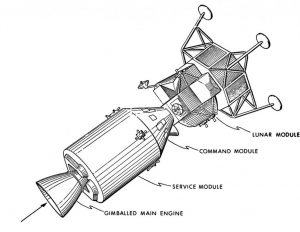 that a rocket could back onto the moon, he finally had to admit defeat. He called John Houbolt, and conceded the lunar landing design to Houbolt’s design, which was, as we all know, completely successful, because after all, his figures did not lie, and he did know what he was talking about. It was a great moment in history, and in Houbolt’s life, except for the fact that no one knew that the successful landing was his design. While the Lunar landing, 50 years ago was an amazing accomplishment, I find it quite sad that it took so many years for the world to know about how one man’s refusal to give up, actually made Lunar landing possible. We owe John Houbolt a great debt of gratitude, and it is more than 50 years overdue. Now that’s ludicrous!!
that a rocket could back onto the moon, he finally had to admit defeat. He called John Houbolt, and conceded the lunar landing design to Houbolt’s design, which was, as we all know, completely successful, because after all, his figures did not lie, and he did know what he was talking about. It was a great moment in history, and in Houbolt’s life, except for the fact that no one knew that the successful landing was his design. While the Lunar landing, 50 years ago was an amazing accomplishment, I find it quite sad that it took so many years for the world to know about how one man’s refusal to give up, actually made Lunar landing possible. We owe John Houbolt a great debt of gratitude, and it is more than 50 years overdue. Now that’s ludicrous!!
 Some of the biggest defeats in any war come from underestimating the enemy or refusing to believe the facts. In the case of Japan it was a little of both. The security of the Marianas Islands, in the western Pacific, was vital to Japan, which had air bases on Saipan, Tinian, and Guam. The United States troops were already battling the Japanese on Saipan, since their arrival there on June 15, 1944. Any further intrusion would leave the Philippine Islands, and Japan itself, vulnerable to US attack. The Japanese needed to maintain their security in the Marianas Islands.
Some of the biggest defeats in any war come from underestimating the enemy or refusing to believe the facts. In the case of Japan it was a little of both. The security of the Marianas Islands, in the western Pacific, was vital to Japan, which had air bases on Saipan, Tinian, and Guam. The United States troops were already battling the Japanese on Saipan, since their arrival there on June 15, 1944. Any further intrusion would leave the Philippine Islands, and Japan itself, vulnerable to US attack. The Japanese needed to maintain their security in the Marianas Islands.
The US Fifth Fleet, commanded by Admiral Raymond Spruance, was on its way northwest from the Marshall Islands. Their mission was to provide backup for the invasion of Saipan and the rest of the Marianas. Whether he knew what was going on or not, 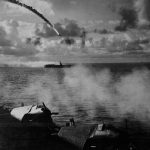 Japanese Admiral Ozawa Jisaburo, decided to challenge the American fleet. He ordered 430 of his planes, launched from aircraft carriers, to attack. The greatest carrier battle of the war was about to begin. The United States picked up the Japanese craft on radar and shot down more than 300 aircraft and sunk two Japanese aircraft carriers. By comparison, the United States only lost 29 of their own planes in the process. Strangely, Admiral Ozawa, believed that his missing planes had landed at their Guam air base. He maintained his position in the Philippine Sea, allowing for a second attack of US carrier-based fighter planes. He made his men sitting ducks!! The secondary attack, commanded by Admiral Mitscher, shot down an additional 65 Japanese planes and sink another carrier. In total, the Japanese lost 480 aircraft…about three-quarters of its total aircraft, not to mention most of its crews. American would dominate the Marianas Islands, and Japan was in deep trouble. The battle was later described as a “turkey shoot.”
Japanese Admiral Ozawa Jisaburo, decided to challenge the American fleet. He ordered 430 of his planes, launched from aircraft carriers, to attack. The greatest carrier battle of the war was about to begin. The United States picked up the Japanese craft on radar and shot down more than 300 aircraft and sunk two Japanese aircraft carriers. By comparison, the United States only lost 29 of their own planes in the process. Strangely, Admiral Ozawa, believed that his missing planes had landed at their Guam air base. He maintained his position in the Philippine Sea, allowing for a second attack of US carrier-based fighter planes. He made his men sitting ducks!! The secondary attack, commanded by Admiral Mitscher, shot down an additional 65 Japanese planes and sink another carrier. In total, the Japanese lost 480 aircraft…about three-quarters of its total aircraft, not to mention most of its crews. American would dominate the Marianas Islands, and Japan was in deep trouble. The battle was later described as a “turkey shoot.”
Not long after this battle at sea, US Marine divisions penetrated farther into the island of Saipan. Two of the 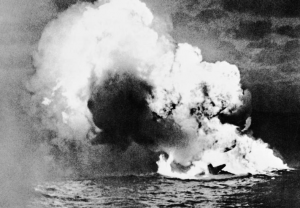 Japanese commanders on the island, Admiral Nagumo and General Saito, both committed suicide in an attempt to rally the remaining Japanese forces. I can’t imagine how that would inspire the forces. It was an act that can only be understood by a sick mind, but their plan worked. Those forces also committed a virtual suicide as they attacked the Americans’ lines, losing 26,000 men compared with 3,500 lost by the United States. Within another month, the islands of Tinian and Guam were also captured by the United States. Due to the disgrace, the Japanese government of Premier Hideki Tojo resigned at this stunning defeat, in what many have described as the turning point of the war in the Pacific.
Japanese commanders on the island, Admiral Nagumo and General Saito, both committed suicide in an attempt to rally the remaining Japanese forces. I can’t imagine how that would inspire the forces. It was an act that can only be understood by a sick mind, but their plan worked. Those forces also committed a virtual suicide as they attacked the Americans’ lines, losing 26,000 men compared with 3,500 lost by the United States. Within another month, the islands of Tinian and Guam were also captured by the United States. Due to the disgrace, the Japanese government of Premier Hideki Tojo resigned at this stunning defeat, in what many have described as the turning point of the war in the Pacific.

